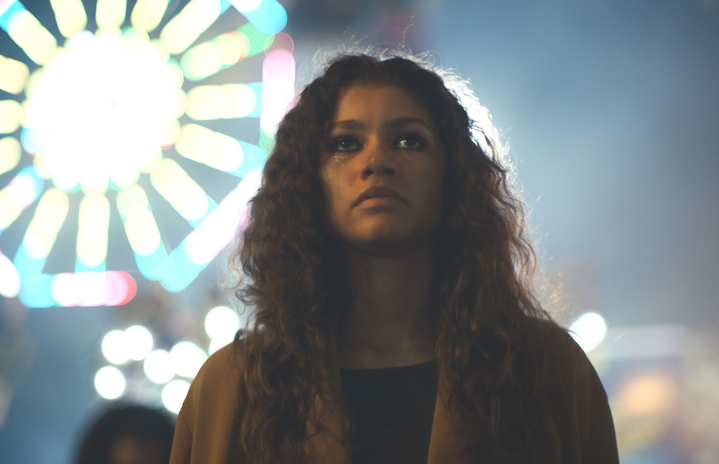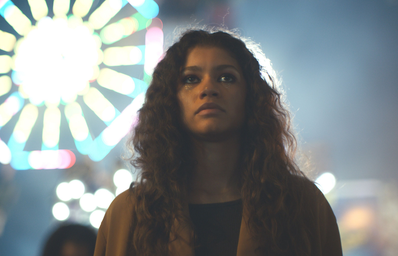Airing every Sunday at 9:00 p.m. EST, HBO Max’s “Euphoria” has broken records, drawing 13.1 million viewers for its first episode of season two. The story follows a group of high schoolers intermixed in the world of drugs and sex while dealing with dysfunctional family dynamics. The show might seem out of character for most teenagers, but there is a reason why millions of high school and college students are sitting down every Sunday to watch–it is horrifyingly similar to many teen’s experiences. For each of the show’s dysfunctional main characters, I could point to a peer with similar antics and issues.
Maddy Perez, played by Alexa Demie, is caught in an unhealthy relationship with an abusive boyfriend: Nate Jacobs, played by Jacob Elordi. Nate himself has arguably the most flawed family in the show and poorly handles his father’s promiscuous lifestyle. Cassie Howard, played by Sydney Sweeney, is Maddy’s best friend and is constantly sexualized by her peers for developing at a young age. Kat Hernandez, played by Barbie Ferreira, tries (and fails) to reclaim her sexuality by posing as a cam girl on an explicit website. Jules Vaughn, played by Hunter Schafer, struggles with the loss of her mother and acts out by randomly hooking up with men and women in their town. The loveable, yet dangerous dug dealer, Fex, played by Angus Cloud, has his own problems regarding who he deals with in his business. Finally, the main character and narrator of the show, Rue Bennett, played by Zendaya, struggles with bipolar disorder and turns to a myriad of addictions to get by.
“Euphoria” accurately equates notoriety and popularity, a relationship that was present in my own high school. People talked about relationships as if it was the juiciest piece of gossip available. When a couple broke up there was only more frenzied talk. The notorious “drug dealer” would attempt to act in complete aloofness to maintain the mystery that gave him his popularity. “Euphoria” depicts these classic high school tropes with terrifying likeness. That, however, is not my critique of the show.
My problem with “Euphoria” comes down to the multitude of dark concepts the characters deal with and the aesthetic that glamorizes it all. Although the artful costumes, makeup and lighting is what makes the show a creative masterpiece, it does so in a way that romanticizes many of the vices. Perhaps the only character who experiences the consequences of her actions is Rue, who frightens her mother, sister and Narcotics Anonymous sponsor by endangering herself multiple times. The other characters repeatedly jeopardize their livelihood,yet avoid major catastrophe and parental intervention. They cleanly dance around a slew of morally dubious situations–and come out looking flawless every time.
In Season 1 Episode 2, “Stuntin Like My Daddy”, Nate gets revenge on a random guy, Tyler, whom Maddy had made out with in the previous episode. Nate breaks into his house, beats him to pulp, and threatens him with statutory rape for hooking up with a minor. Although he breaks many laws during this violent encounter—breaking and entering and assault and battery, just to name a few—it was completely brushed over in the season one finale and has yet to come up in season two. A more recent example in season two’s pilot episode features Nate drinking and driving to the New Year’s Eve Party. He ends up getting to the party completely unscathed. Similarly, Cal Jacobs, Nate’s father, drinks and drives in episode four of season two, but is completely unharmed the entire episode. In a recent season two interlude, Rue escapes rehab and finds herself about to be sex trafficked at her dealer’s home. She has a long and windy police chase where she makes her way across rush hour traffic. Labyrinth’s music overlays much of the chase and brightens the mood of the scene, taking away from the seriousness of the situation. Although the episode might have been intended to serve as a warning, it seemed more like a road map that sensationalized its subject matter and neglected to pose the risks.
To make matters even more sensationalized, the costumes, makeup, and actors themselves are seemingly flawless (appearance-wise) the entire show. Samuel Getachew of Vogue, said, “The main characters are all stunningly beautiful and decidedly postpubescent, and their day-to-day attire frequently features glitter, immaculate makeup, and over-the-top outfits, which they wear even through their most traumatizing experiences. The cinematography of the show almost resembles that of a music video, with moody, glowing lighting and dramatic, elaborate motion shots.”
“Euphoria” is a cultural masterpiece, but maybe for the wrong reasons. The marketing is too addicting, the aesthetic almost too attractive to be portraying such dark matter. If this new season cannot find a concrete thesis to accompany its visuals, “Euphoria” might find itself in the midst of a generation of overexposed teenagers.

